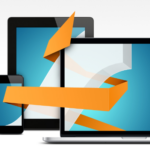By Jerome Haldemann
A brief history of pictograms and ideograms
A pictogram, also called pictograph, picto or simply icon, is the most simple and efficient way to convey a message or an idea and has been used throughout civilization – from the prehistoric age, to ancient Egypt, until today. Pictograms have constantly evolved over the centuries. Often they’ve been associated with magic powers, used to convey religious ideas or even been used as a secret code.
Nowadays icons serve a more utilitarian purpose. Because of the industrial revolution and globalisation, people everywhere are establishing themselves in foreign countries using the same technologies to work and communicate. This is what I call a universal lifestyle. But, for this to work we need to communicate in a universal language that everyone can understand whatever their language or culture.
Pictograms and ideograms
A pictogram is a symbol that conveys meaning through its resemblance to a physical object. Examples of pictograms include wayfinding signage, such as in airports and other environments where many people may not be familiar with the language of the place they are in.

The departure pictogram displayed in every airport is understood by everyone.
In some cases, pictograms can be coupled with ideograms. Ideograms are graphical symbols that represent an idea or concept. Good examples of ideogram are the red circle that means “not allowed”, or the orange or yellow triangle that means “attention” or “danger”.

A good example of a pictogram and ideogram combination
We can see pictograms and ideograms everywhere. They are on road signage, buildings, streets, train stations, electronic devices, computers, etc. They reproduce in a very simple manner what our eyes see and can easily be understood by anybody.
Today there are thousands of pictograms and ideograms that have been universally accepted and we directly recognise them at a first glance. Popular examples are the email icon, the telephone icon, the play button, the download button, etc. Some of them are pictograms, others are ideograms and some are a mix of both.
Sometimes a pictogram is also playing the role of an ideogram. For example, the icon that represents the meaning of the idea is represented by a light bulb. Even if the light bulb is in fact the representation of an object (a pictogram), it conveys the message of the idea, a concept (an ideogram).

Here the ‘idea’ icon is represented by a pictogram which is used as an ideogram. This example is amplified by another ideogram, the light beams.
Creating an icon is not an easy task for a designer
Because an icon must be universal, it can be very tricky for a designer to create a workable icon. There are so many things to take into consideration. For example, a representation of something could be interpreted differently depending on someone’s culture, beliefs or religion. Colours might also be best avoided. In Europe red is a common symbol for danger, but in China red symbolises good fortune and is believed to ward away evil.
Some words are considered impossible to transcribe into a pictogram without the help of text. Try to represent an ‘account manager’ as an icon for example. It might not seem too hard at first sight but when you think about it, you’ll soon realise that it’s not an easy task at all.
It’s also very risky to try to do something differently when creating a new icon. If a triangle in a circle means play, don’t try to reinvent the wheel. It’ll simply confuse people. Icons are not always the place to be creative.
Up for the challenge? If you’re interested about how to design a great icon, you should take a look at Muddasar Bagwan’s blog post: What makes a great icon?
Are some of the existing icons still up to date today?
When I look at some of the most popular icons of today a question always pops into my mind: “How long are we going to keep these without updating them?” This question particularly applies for the technology which is constantly evolving year after year. The electronic devices become smaller, thinner, able to multitask and equipped with touch screens. Their shapes are also changing, as well as the way we are using them. Generation Z is born with tablets and smartphones. So are they really identifying themselves to an old-fashioned phone receiver we are using to represent calls? Are they aware that the voicemail icon used by Apple is actually a tape recorder? Do they actually know what a tape recorder is? Those are the kind of questions I’m always asking myself when looking at my smartphone or computer. It seems that those types of icons are becoming ideograms instead of pictograms for them. Symbols that finally are universally been accepted as the official representation of an idea or a concept.

Could this be the new version of the famous ‘call’ icon? Maybe more easily understood by the new generation?

Is this icon still correctly understood today?
Conclusion
There have never been as many icons as today. They have evolved for centuries. Since the industrial revolution and the dawn of globalisation, iconshave started to appear everywhere and their popularity has evolved as technology evolves. Icons are increasingly becoming a universal language in which each symbol has a particular meaning. To update or change an already well-known icon is too risky, regardless of whether generation z can identify the object represented or not. As long as people can instantly understand it’s meaning, there’s no reason to introduce confusion. It’s like changing a language – a universal way to communicate. And this is what icons are really all about: visual communication.
By Jerome Haldemann
A brief history of pictograms and ideograms
A pictogram, also called pictograph, picto or simply icon, is the most simple and efficient way to convey a message or an idea and has been used throughout civilization - from the prehistoric age, to ancient Egypt, until today. Pictograms have constantly evolved over the centuries. Often they’ve been associated with magic powers, used to convey religious ideas or even been used as a secret code.
Nowadays icons serve a more utilitarian purpose. Because of the industrial revolution and globalisation, people everywhere are establishing themselves in foreign countries using the same technologies to work and communicate. This is what I call a universal lifestyle. But, for this to work we need to communicate in a universal language that everyone can understand whatever their language or culture.
Pictograms and ideograms
A pictogram is a symbol that conveys meaning through its resemblance to a physical object. Examples of pictograms include wayfinding signage, such as in airports and other environments where many people may not be familiar with the language of the place they are in.

The departure pictogram displayed in every airport is understood by everyone.
In some cases, pictograms can be coupled with ideograms. Ideograms are graphical symbols that represent an idea or concept. Good examples of ideogram are the red circle that means “not allowed”, or the orange or yellow triangle that means “attention” or “danger”.

A good example of a pictogram and ideogram combination
We can see pictograms and ideograms everywhere. They are on road signage, buildings, streets, train stations, electronic devices, computers, etc. They reproduce in a very simple manner what our eyes see and can easily be understood by anybody.
Today there are thousands of pictograms and ideograms that have been universally accepted and we directly recognise them at a first glance. Popular examples are the email icon, the telephone icon, the play button, the download button, etc. Some of them are pictograms, others are ideograms and some are a mix of both.
Sometimes a pictogram is also playing the role of an ideogram. For example, the icon that represents the meaning of the idea is represented by a light bulb. Even if the light bulb is in fact the representation of an object (a pictogram), it conveys the message of the idea, a concept (an ideogram).

Here the ‘idea’ icon is represented by a pictogram which is used as an ideogram. This example is amplified by another ideogram, the light beams.
Creating an icon is not an easy task for a designer
Because an icon must be universal, it can be very tricky for a designer to create a workable icon. There are so many things to take into consideration. For example, a representation of something could be interpreted differently depending on someone’s culture, beliefs or religion. Colours might also be best avoided. In Europe red is a common symbol for danger, but in China red symbolises good fortune and is believed to ward away evil.
Some words are considered impossible to transcribe into a pictogram without the help of text. Try to represent an ‘account manager’ as an icon for example. It might not seem too hard at first sight but when you think about it, you’ll soon realise that it’s not an easy task at all.
It’s also very risky to try to do something differently when creating a new icon. If a triangle in a circle means play, don’t try to reinvent the wheel. It’ll simply confuse people. Icons are not always the place to be creative.
Up for the challenge? If you’re interested about how to design a great icon, you should take a look at Muddasar Bagwan’s blog post: What makes a great icon?
Are some of the existing icons still up to date today?
When I look at some of the most popular icons of today a question always pops into my mind: “How long are we going to keep these without updating them?” This question particularly applies for the technology which is constantly evolving year after year. The electronic devices become smaller, thinner, able to multitask and equipped with touch screens. Their shapes are also changing, as well as the way we are using them. Generation Z is born with tablets and smartphones. So are they really identifying themselves to an old-fashioned phone receiver we are using to represent calls? Are they aware that the voicemail icon used by Apple is actually a tape recorder? Do they actually know what a tape recorder is? Those are the kind of questions I’m always asking myself when looking at my smartphone or computer. It seems that those types of icons are becoming ideograms instead of pictograms for them. Symbols that finally are universally been accepted as the official representation of an idea or a concept.

Could this be the new version of the famous ‘call’ icon? Maybe more easily understood by the new generation?

Is this icon still correctly understood today?
Conclusion
There have never been as many icons as today. They have evolved for centuries. Since the industrial revolution and the dawn of globalisation, iconshave started to appear everywhere and their popularity has evolved as technology evolves. Icons are increasingly becoming a universal language in which each symbol has a particular meaning. To update or change an already well-known icon is too risky, regardless of whether generation z can identify the object represented or not. As long as people can instantly understand it’s meaning, there’s no reason to introduce confusion. It’s like changing a language - a universal way to communicate. And this is what icons are really all about: visual communication.








One Response
In my opinions, pictograms
In my opinions, pictograms are signs or symbols that are easily recognisable. They help to convey a message in a short and simple way which is easy to be understood. We can see such pictograms especially on the streets to serve as a precautionary sign or for safety reasons. The simple and catchy pictures help people to understand the message at the very first glance.